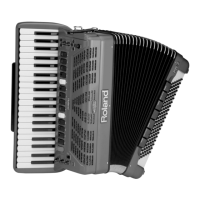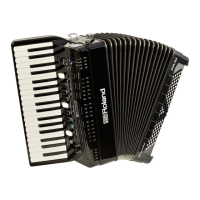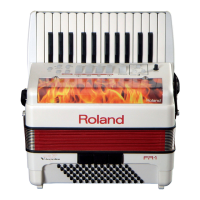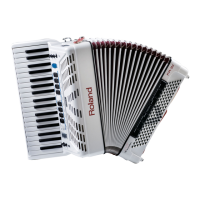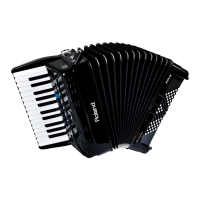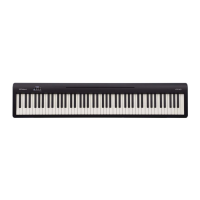Selecting Parameters
81
Parameter Value Explanation
RESO –64~0~+63
When the Resonance value is increased, the
overtones in the area of the cuto frequency
will be emphasized, creating a sound with a
strong character.
NOTE
For some sounds, negative (–) “Resonance”
settings may produce no noticeable
change because the Resonance is already
set to the minimum value.
5.6 Controllers
These parameters further add to the realism of the
sounds emulated by your FR-8x.
Parameter Value Explanation
AFTERTOUCH
O, 1/4 Down,
1/2 Down, 1/4 Up,
1/2 Up
The right hand keyboard of the
piano-type model generates
aftertouch messages (on the
button-type model, aftertouch
can be generated with the Master
bar). “Aftertouch” refers to the fact
that you press a key even further
down after playing a note. This
eect allows you to bend the pitch
down (temporarily lower the note)
by a quarter (“1/4 Down”) or a
semi-tone (“1/2 Down”). Select “1/4
Up” or “1/2 Up” to bend the notes
up a quarter or a semi-tone. Select
“O” to switch o the Orchestra
section’s aftertouch recognition.
The treble section also contains
this parameter. You are thus free
to decide whether the Orchestral
1 sound should be aected by
aftertouch messages or only one
of them.
NOTE
This aftertouch eect applies
to all Orchestra 1 notes that are
sounding simultaneously.
BELLOWS
DETUNE
O, Low, Standard,
High
This parameter allows you to
specify how strongly the orchestral
sound’s pitch should be inuenced
by opening and closing the
bellows faster than usual.
If the “Standard” setting seems too
mild, try “High”.
If it is too strong, use “Low”.
If you do not want any detuning
eect, select “O”. The most
convincing setting usually depends
on the selected sound.
EXP PEDAL O, On
• Select “O” If you want to use
the bellows for expressive
purposes.
• Select “On” if you want
control the expression by foot
purchasing an optional MIDI
foot controller (e.g. FC-300).
Parameter Value Explanation
ORCH 1 TOUCH
Fixed Low, Fixed
Med., Fixed High,
Low, Medium, High,
Fixed Low+Bellows,
Fixed Med.+Bellows,
Fixed High+Bellows,
Bellows
This parameter allows you to
specify the velocity sensitivity
of the Right Hand section keys
when they are used to play
Orchestral 1 sounds.
• There are three “Fixed” curves
that always use the same
value, no matter how hard or
lightly you press the keys (no
dynamic control). “Low” means
that a low value is used, “Med”
represents a medium value and
“High” a high value.
• “Low”: means that even
relatively light key presses
already allow you to play loud
notes.
• “Medium”: is in the middle of
Low and High.
• “High”: represents the most
responsive velocity curve that
requires a considerable amount
of strength for fortissimo notes,
but it also provides more
expressive options.
• “Heavy”: provides a greater
variety of nuances.
• “Fixed Low+Bellows“, “ Fixed
Med.+Bellows”, “ Fixed
High+Bellows”: mean that
the selected orchestral sound
uses xed velocity values but
can also be controlled by the
bellows movements.
• “Bellows”: means that the
selected orchestral sound
is controlled by the bellows
movements - not the velocity
values generated by the keys.
NOTE
The “ORCH 1 TOUCH” parameter
does not act if the orchestral
sound selected can be
controlled by bellows only.
For details regarding these
sounds refer to the“Tone &
Drum Kit List “ supplementary
manual.
Download it from the Web:
http:/ www.roland.com/
manuals/
5.7 MIDI TX
This page contains a series of MIDI parameters for
the Orchestra 1 section you need to set one by
one.
These parameters are saved along with all other
Set parameters, which allows you to use dierent
MIDI settings for each Set and even each register
within a Set.
Parameter Value Explanation
Note Tx
On, O
Default: On
See “2.7 MIDI TX” (p. 73) for
details.
Octave
–3~0~+3
Default: 0
See “2.7 MIDI TX” (p. 73) for
details.
CC 00
Std, O, 0~127
Default: Std
See “2.7 MIDI TX” (p. 73) for
details.
CC 32

